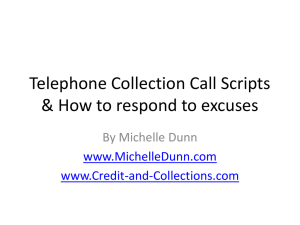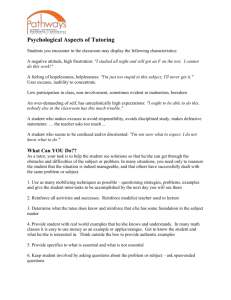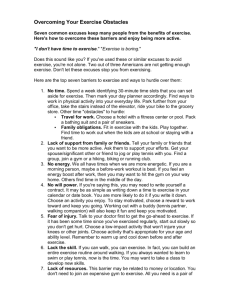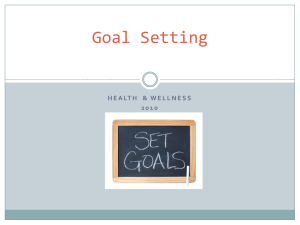Optimizing Positive Student Behavior
advertisement
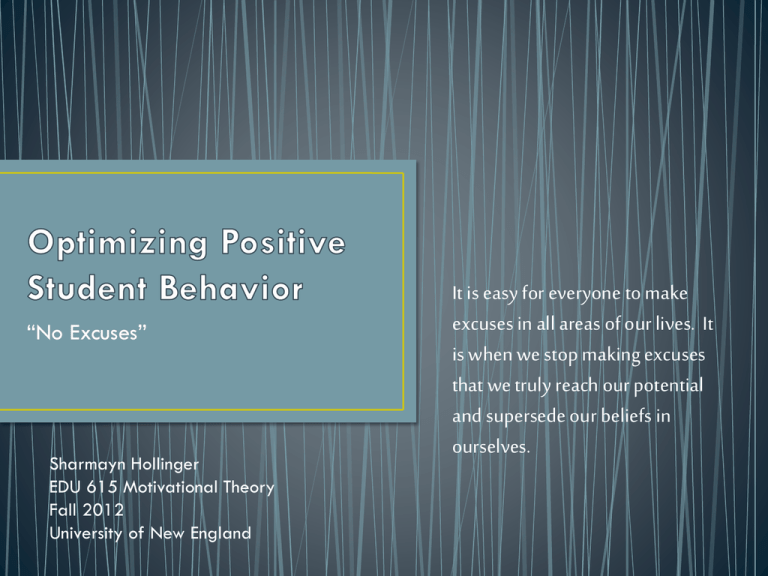
“No Excuses” Sharmayn Hollinger EDU 615 Motivational Theory Fall 2012 University of New England It is easy for everyone to make excuses in all areas of our lives. It is when we stop making excuses that we truly reach our potential and supersede our beliefs in ourselves. Video retrieved from https://www.youtube.com/watch?v=obdd31Q9PqA • By adopting a “No Excuse” policy in your school you are accepting a philosophy that all students CAN achieve at high levels. We have adopted a ‘No Excuse’ philosophy. We expect all students to achieve at high levels. It is easy to come up with excuses for not doing something and it is even easier for people to come up with excuses for their negative behaviour. By adopting a no excuse policy and the fundamental belief that all students can and will achieve at high levels not only places ownership for bad behavior onto the student it also sets up a child for success not matter what life they come from and what they bring to their learning environment. As a teacher it is our job to model the behavior we wish to see our student exude. In our role as educators there are behaviors that we must exude and beliefs we must adhere to. These are described as non negotiables they are not to be altered or diverged from. All educators must stand by these non negotiables. When instilling and modelling positive behaviour Every child deserves and must be treated with respect. We cannot control the lives they live outside our building but we can control the life they live inside our walls. A safe and nurturing environment to grow and thrive- No Excuses and no exceptions, this is not negotiable! In order for students to reach their full potential they need to be in a safe, supportive, and nurturing environment where they feel safe to take risks make mistakes and be accepted for who they are. No Excuses, no exceptions, not negotiable! (Intervention First/Assessment Of/As/For Learning/Collaborative Culture) Start off by having staff come together and decide on a common language to be used throughout the school. Consistency and structure are key! Clear outline of what is expected of students! Not only has it been stated in research the proof is alive in our building!! The following slides is how our small school with the big heart has come together to minimize student behavior issues and optimize learning time! Provide students with: School and Classroom • Safe, welcoming, and comforting environment inclusive to optimized learning opportunities. • Common language and expectations amongst staff. • Support and acceptance of who they are. The behavior you model to students matter. Image Retrieved from http://alloutofsorts.com/blog/?tag=/kids Image retrieved from http://www.graphicsfactory.com/search/education_P1.ht ml Your behavior must exude the behavior you wish the children to show. No child in an educational setting deserves to be yelled at, belittled, or treated in a condescending manner. Our entire staff: • Models behaviour • Inclusive practices- all students are an important • Has clear expectations and part of the classroom procedures • Structured atmosphere • Consistently follows procedures • Does not accept excuses • Adheres to school wide • Does not give excuses “codes of conduct” • Expects that all students WILL • Provides a safe environment ACHIEVE at high levels for all learners Effective teachers typically have specific characteristics in common-- positive expectations for student success- Harry Wong Self Control Respect Empathy Kindness Tolerance Fairness Conscience • Clearly discuss with students expectations • Brainstorm together what each virtue looks like, sounds like and feels like • Model the virtue • Reinforce positive expression of the virtue • Place ownership of behavior on the individual • Tier one- strategies are utilized by the classroom teacher. • Tier two- collaboration with teachers and support staff to implement and utilize interventions • Tier Three- after other avenues have been exhausted and behavior is an ongoing concern, and many strategies have been drained the school team takes the concerns to the school based consultant team for further assistance and guidance. No excuses Non Negotiables Seven Virtues Tiered Intervention References Carter, Samuel C.,(2000) No Excuses Lessons from 21 High-Performing, High-Poverty Schools. Retrieved from http://www.nzbr.org.nz/site/nzbr/files/Carter%20No%20Excuses%20Lessons%20 High%20Poverty%20Schools%20Heritage%202000.pdf Government of Manitoba.,(2012) Classroom Behavioural Strategies and Interventions. Retrieved from http://www.edu.gov.mb.ca/k12/specedu/fas/pdf/5.pdf. PBIS.Org ., (2012) Positive Behavioral Interventions and Supports. Retrieved from http://www.pbis.org/. Wong, Harry K.; (2007) Professional Reference for Teachers: The Well Managed Classroom. Retrieved fromhttp://go.hrw.com/resources/go_sc/gen/HSTPR034.PDF. The 21st Century Learning Initiative.,(2012) Born To Learn. Retrieved from http://www.bornto-learn.org/home/blog/we-learn-through-modelling-behaviour/.

